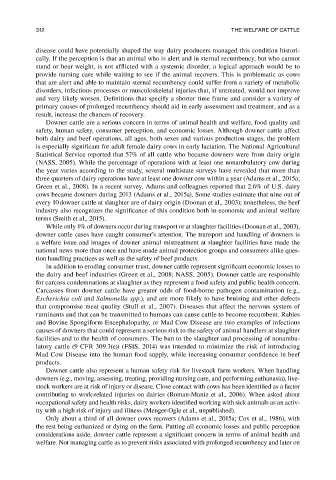Page 335 - The Welfare of Cattle
P. 335
312 the WeLfare of CattLe
disease could have potentially shaped the way dairy producers managed this condition histori-
cally. If the perception is that an animal who is alert and in sternal recumbency, but who cannot
stand or bear weight, is not afflicted with a systemic disorder, a logical approach would be to
provide nursing care while waiting to see if the animal recovers. This is problematic as cows
that are alert and able to maintain sternal recumbency could suffer from a variety of metabolic
disorders, infectious processes or musculoskeletal injuries that, if untreated, would not improve
and very likely worsen. Definitions that specify a shorter time frame and consider a variety of
primary causes of prolonged recumbency should aid in early assessment and treatment, and as a
result, increase the chances of recovery.
Downer cattle are a serious concern in terms of animal health and welfare, food quality and
safety, human safety, consumer perception, and economic losses. Although downer cattle affect
both dairy and beef operations, all ages, both sexes and various production stages, the problem
is especially significant for adult female dairy cows in early lactation. The National Agricultural
Statistical Service reported that 57% of all cattle who became downers were from dairy origin
(NASS, 2005). While the percentage of operations with at least one nonambulatory cow during
the year varies according to the study, several multistate surveys have revealed that more than
three quarters of dairy operations have at least one downer cow within a year (Adams et al., 2015a;
Green et al., 2008). In a recent survey, Adams and colleagues reported that 2.6% of U.S. dairy
cows became downers during 2013 (Adams et al., 2015a). Some studies estimate that nine out of
every 10 downer cattle at slaughter are of dairy origin (Doonan et al., 2003); nonetheless, the beef
industry also recognizes the significance of this condition both in economic and animal welfare
terms (Smith et al., 2015).
While only 1% of downers occur during transport or at slaughter facilities (Doonan et al., 2003),
downer cattle cases have caught consumer’s attention. The transport and handling of downers is
a welfare issue and images of downer animal mistreatment at slaughter facilities have made the
national news more than once and have made animal protection groups and consumers alike ques-
tion handling practices as well as the safety of beef products.
In addition to eroding consumer trust, downer cattle represent significant economic losses to
the dairy and beef industries (Green et al., 2008; NASS, 2005). Downer cattle are responsible
for carcass condemnations at slaughter as they represent a food safety and public health concern.
Carcasses from downer cattle have greater odds of food-borne pathogen contamination (e.g.,
Escherichia coli and Salmonella spp.), and are more likely to have bruising and other defects
that compromise meat quality (Stull et al., 2007). Diseases that affect the nervous system of
ruminants and that can be transmitted to humans can cause cattle to become recumbent. Rabies
and Bovine Spongiform Encephalopathy, or Mad Cow Disease are two examples of infectious
causes of downers that could represent a serious risk to the safety of animal handlers at slaughter
facilities and to the health of consumers. The ban to the slaughter and processing of nonambu-
latory cattle (9 CFR 309.3(e)) (FSIS, 2014) was intended to minimize the risk of introducing
Mad Cow Disease into the human food supply, while increasing consumer confidence in beef
products.
Downer cattle also represent a human safety risk for livestock farm workers. When handling
downers (e.g., moving, assessing, treating, providing nursing care, and performing euthanasia), live-
stock workers are at risk of injury or disease. Close contact with cows has been identified as a factor
contributing to work-related injuries on dairies (Roman-Muniz et al., 2006). When asked about
occupational safety and health risks, dairy workers identified working with sick animals as an activ-
ity with a high risk of injury and illness (Menger-Ogle et al., unpublished).
Only about a third of all downer cows recovers (Adams et al., 2015a; Cox et al., 1986), with
the rest being euthanized or dying on the farm. Putting all economic losses and public perception
considerations aside, downer cattle represent a significant concern in terms of animal health and
welfare. Not managing cattle as to prevent risks associated with prolonged recumbency and later on

